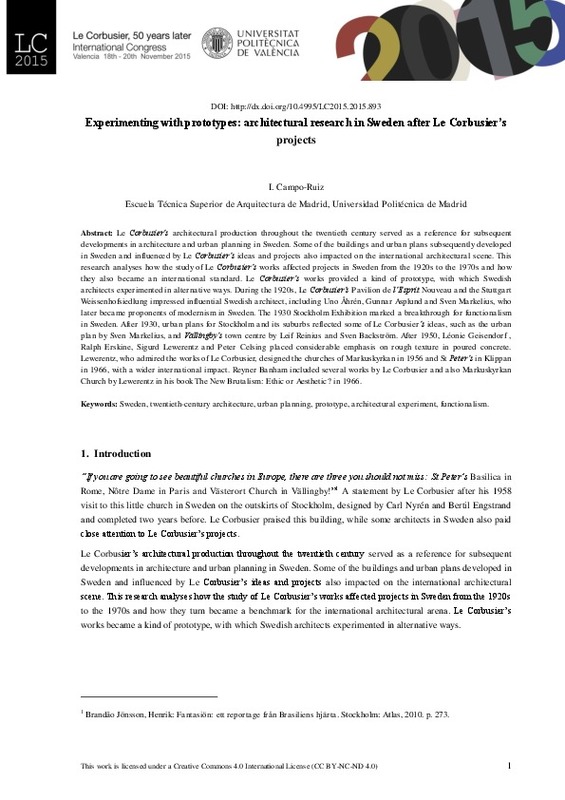JavaScript is disabled for your browser. Some features of this site may not work without it.
Buscar en RiuNet
Listar
Mi cuenta
Estadísticas
Ayuda RiuNet
Admin. UPV
Experimenting with prototypes: architectural research in Sweden after Le Corbusier’s projects
Mostrar el registro sencillo del ítem
Ficheros en el ítem
| dc.contributor.author | Campo-Ruiz, Ingrid
|
es_ES |
| dc.date.accessioned | 2017-09-13T06:27:31Z | |
| dc.date.available | 2017-09-13T06:27:31Z | |
| dc.date.issued | 2016-03-03 | |
| dc.identifier.isbn | 9788490483732 | |
| dc.identifier.uri | http://hdl.handle.net/10251/87134 | |
| dc.description.abstract | [EN] Le Corbusier’s architectural production throughout the twentieth century served as a reference for subsequent developments in architecture and urban planning in Sweden. Some of the buildings and urban plans subsequently developed in Sweden and influenced by Le Corbusier’s ideas and projects also impacted on the international architectural scene. This research analyses how the study of Le Corbusier’s works affected projects in Sweden from the 1920s to the 1970s and how they also became an international standard. Le Corbusier’s works provided a kind of prototype, with which Swedish architects experimented in alternative ways. During the 1920s, Le Corbusier’s Pavilion de l’Esprit Nouveau and the Stuttgart Weissenhofsiedlung impressed influential Swedish architect, including Uno Åhrén, Gunnar Asplund and Sven Markelius, who later became proponents of modernism in Sweden. The 1930 Stockholm Exhibition marked a breakthrough for functionalism in Sweden. After 1930, urban plans for Stockholm and its suburbs reflected some of Le Corbusier’s ideas, such as the urban plan by Sven Markelius, and Vällingby’s town centre by Leif Reinius and Sven Backström. After 1950, Léonie Geisendorf , Ralph Erskine, Sigurd Lewerentz and Peter Celsing placed considerable emphasis on rough texture in poured concrete. Lewerentz, who admired the works of Le Corbusier, designed the churches of Markuskyrkan in 1956 and St Peter’s in Klippan in 1966, with a wider international impact. Reyner Banham included several works by Le Corbusier and also Markuskyrkan Church by Lewerentz in his book The New Brutalism: Ethic or Aesthetic? in 1966 | es_ES |
| dc.format.extent | 13 | es_ES |
| dc.language | Inglés | es_ES |
| dc.publisher | Editorial Universitat Politècnica de València | es_ES |
| dc.relation.ispartof | LE CORBUSIER. 50 AÑOS DESPUÉS | es_ES |
| dc.rights | Reconocimiento - No comercial - Sin obra derivada (by-nc-nd) | es_ES |
| dc.subject | architecture | es_ES |
| dc.subject | le corbusier | es_ES |
| dc.subject | modern movement | es_ES |
| dc.title | Experimenting with prototypes: architectural research in Sweden after Le Corbusier’s projects | es_ES |
| dc.type | Capítulo de libro | es_ES |
| dc.type | Comunicación en congreso | es_ES |
| dc.identifier.doi | 10.4995/LC2015.2015.893 | |
| dc.rights.accessRights | Abierto | es_ES |
| dc.description.bibliographicCitation | Campo-Ruiz, I. (2016). Experimenting with prototypes: architectural research in Sweden after Le Corbusier’s projects. En LE CORBUSIER. 50 AÑOS DESPUÉS. Editorial Universitat Politècnica de València. 272-284. https://doi.org/10.4995/LC2015.2015.893 | es_ES |
| dc.description.accrualMethod | OCS | es_ES |
| dc.relation.conferencename | LC2015 - Le Corbusier, 50 years later | es_ES |
| dc.relation.conferencedate | November 18-20,2015 | es_ES |
| dc.relation.conferenceplace | Valencia, Spain | es_ES |
| dc.relation.publisherversion | http://ocs.editorial.upv.es/index.php/LC2015/LC2015/paper/view/893 | es_ES |
| dc.description.upvformatpinicio | 272 | es_ES |
| dc.description.upvformatpfin | 284 | es_ES |
| dc.type.version | info:eu-repo/semantics/publishedVersion | es_ES |
| dc.relation.pasarela | OCS\893 | es_ES |








